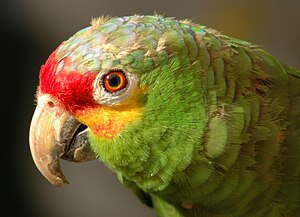Yellow-cheeked Parrot
| Yellow-cheeked Parrot | ||||||||||||
|---|---|---|---|---|---|---|---|---|---|---|---|---|

Yellow-cheeked Amazon ( Amazona autumnalis ) |
||||||||||||
| Systematics | ||||||||||||
|
||||||||||||
| Scientific name | ||||||||||||
| Amazona autumnalis | ||||||||||||
| ( Linnaeus , 1758) |
The yellow-cheeked amazon ( Amazona autumnalis ) is a species of parrot from the subfamily of the New World parrots .
description
The basic color of the plumage of this Amazon species, which can grow to be 34 centimeters, is green. The forehead and the reins of the eyes are red on the head. The green feathers have violet-blue tips on the vertex and neck and are lined with black-violet. The feathers on the upper cheeks and on the ear covers are yellowish to green-yellowish. The beak is yellowish horn-colored. The irises of the eyes are orange and the feet are greenish-gray in color. The species has no sexual dimorphism .
Subspecies
In addition to the nominate form Amazona autumnalis autumnalis , three other subspecies are described, which differ slightly in their plumage.
- The Salvina Parrot ( Amazona autumnalis salvini ) differs from the nominate form in that it has green cheeks and ear covers.
- The Ecuadorian Amazon ( Amazona autumnalis lilacina ) has a more extensive red color on the head
- The diademed parrot ( Amazona autumnalis diadema ) is slightly larger than the nominate form and has a much more colorful head. In this subspecies, the forehead is brick-red, the reins of the eyes a little more intense red than the forehead, the crown is purple, while the cheeks are yellow-green.
distribution
The distribution area of this species extends from eastern Mexico in a southerly direction to the Amazon basin and western Ecuador . They use a number of different habitats within this large and partly disjoint distribution area. They occur in wet and rainforest areas, in pine and deciduous forests, use mangrove and swamp areas as well as gallery forests and can also be found in regions that are subject to greater agricultural use.
behavior
In addition to fruits, seeds, nuts, berries, flowers and buds, the parrots also eat agricultural crops such as citrus fruits, mango and even coffee beans. Yellow-cheeked amazons live in pairs, in family groups or in flocks of up to 100 animals. Their breeding season depends on the distribution area. In Ecuador, yellow-cheeked amazons breed from January to March, in Panama from February to April and in Belize from March to May. The clutch comprises three to four eggs. The breeding season is 25 to 26 days.
Duration
While the yellow-cheeked amazon as such is not considered threatened, this does not apply to individual subspecies. The Ecuadorian Amazon is one of the most threatened subspecies of the Amazon Parrots. Their existence is estimated at only four hundred to six hundred individuals. Large-scale destruction of the habitat and the catch for the animal trade are primarily responsible for the decline.
swell
Individual evidence
- ↑ Lantermann (2007), p. 151.
- ^ Sabine Lantermann, Werner Lantermann, p. 125.
- ↑ Lantermann (2007), p. 152.
- ↑ Lantermann (2007), p. 152.
- ↑ Lantermann (2007), p. 152.
literature
- Susanne Lantermann, Werner Lantermann: The parrots of Central and South America. M. & H. Schaper Verlag, Hannover 1986, ISBN 3-7944-0149-2 .
- Werner Lantermann: Amazon parrots - biology, endangerment, keeping, species. Filander Verlag, 2007, ISBN 978-3-930831-66-1 .
- John Stoodley, Pat Stoodley: Genus Amazona. Bezels Publications, Lovedean 1990, ISBN 0-947756-02-7 .
Web links
- Videos, photos and sound recordings of Amazona autumnalis in the Internet Bird Collection
- Amazona autumnalis inthe IUCN 2013 Red List of Threatened Species . Listed by: BirdLife International, 2012. Retrieved September 26, 2013.
